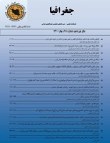Identification and Ranking of the Factors Affecting the Water Crisis in Isfahan Province
Water is one of the main elements of life and the basis of a wide range of socio-economic activities, and its lack causes serious problems in life. Population growth and the development of industrial and agricultural activities have increased the demand for water resources and turned water supply into one of the main challenges in arid and semi-arid regions. According to climatic classifications, large parts of Isfahan province have dry and semi-dry weather and the average annual rainfall is about 163 millimeters. However, this province has been faced with the increase in economic activities and population growth for the last 6 decades, which over time has led to a chronic lack of water, and since the last two decades, with the worsening of the water shortage situation, some signs of water crisis have appeared. Some of them are: the complete interruption of the flow of the Zayandehroud river in a large part of its riverbed, the complete drying of the Gavkhuni wetland in the downstream, the occurrence of subsidence in a large number of plains of the province, the unemployment of farmers in the downstream of the river, and persistent political and social protests. Therefore, identifying the factors affecting the occurrence of water crisis in the province is one of the most important steps in facing this phenomenon, and the current research seeks to identify the factors that cause this situation and rank these factors.
The present research method is descriptive-analytical, and in order to identify the factors affecting the water crisis in Isfahan province, the data was collected through the literature review. The collected affecting factors categorized into 7 main factors and 27 sub-factors. Then, they organized in the form of a questionnaire, and after that by referring to 15 experts and specialists; the initially identified factors were modified and ranked through the Analytic Hierarchy Process (AHP) technique using the Expert Choice software. In this stage, the factors that based on the answers of the experts their average score was less than 3 were eliminated, and thus the final factors were reduced to 5 main factors and 16 sub-factors.
Due to its centrality in the country and due to political considerations and despite severe climatic limitations, since the last 6 decades, Isfahan province has faced the establishment of large industrial factories and the development of agriculture, followed by the increase in population and the growth of urbanization and immigration. This situation and the sharp increase in water consumption have caused the province to face a severe shortage and even signs of a water crisis. The findings of the research show that the five political, human, agricultural, industrial and climatic factors have the greatest influence on the occurrence of water shortage and crisis in the province with weights of 0.325, 0.271, 0.189, 0.124 and 0.091 respectively. Among the five identified main factors affecting the water crisis in Isfahan province, the political factor has played the biggest role. It can be said that the current state of the water crisis in the province is the result of the decisions of the political managers in the past 6 decades, which has intensified over time. Since the last two decades, some obvious signs of the water crisis have appeared in the region. The complete interruption of the flow of the Zayandehrud river in large part of its riverbed and the drying up of the Gavkhuni wetland are the most notable cases. Also the land subsidence in large number of plains even in Isfahan city, which caused damage to houses, public places and historical and touristic buildings. The unemployment rate increased among the farmers in the downstream due to the lack of sufficient water for farming leads persistent socio-political protests.
The continuous development of industries, cities, agriculture, and the population of the province has increased the demand for water consumption and destroyed the ecological balance, and threatened the water resources. With the continuation of the increase in the establishment of industries, immigration, development of agriculture and services in Isfahan province, the situation of water shortage is intensifying over the time. It seems that in order to improve the situation, it is necessary for the policy makers to reconsider the fact that Isfahan province is an industrial hub and has the first rank in many cases of agricultural and industrial production. They should decide for the gradual transfer of high water-consuming industries and the control of immigration and revision in development plans and changing the cultivation pattern of agricultural crops towards low water-consuming crops, which are appropriate to the province's climate.
- حق عضویت دریافتی صرف حمایت از نشریات عضو و نگهداری، تکمیل و توسعه مگیران میشود.
- پرداخت حق اشتراک و دانلود مقالات اجازه بازنشر آن در سایر رسانههای چاپی و دیجیتال را به کاربر نمیدهد.




